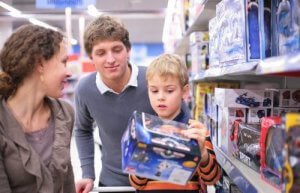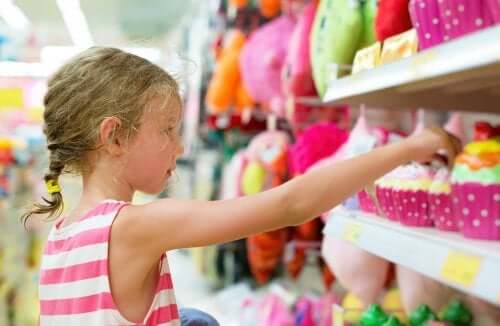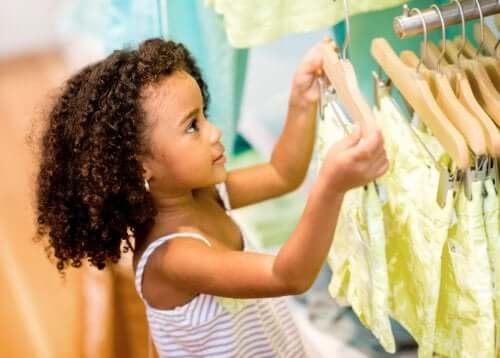Keys for Avoiding Compulsive Consumerism in Children

Compulsive consumerism in children is an increasingly present problem in developed countries. It’s common knowledge that any activity we perform in a compulsive manner is harmful. So, how can we avoid constant consumerism in children? What are the keys to prevent this habit?
Around the holiday season, consumerism in children increases even more… if that’s even possible. There are so many messages coming at us that promote massive consumption. This bombardment doesn’t come just from the media – like TV and the internet – but also from family members and school friends as well.
The message – whether implicit or explicit – fills us with the belief that we must continue to buy, whether we need to or not. Especially during the holidays, children are the biggest target or publicity campaigns. Almost all television commercials turn towards this group the attract their attention.
Without a doubt, the holidays are one of the most beautiful times of the year. It’s a season full of family gatherings, festive music, previous memories, and delicious food. But the holidays also have their downside, as they have a tendency to make us slaves to consumerism. The truth is, our society as a whole has fallen victim to compulsive consumerism.
“Advertising tries to stimulate our sensuous desires, converting luxuries into necessities, but it only intensifies man’s inner misery. The business world is bent on creating hungers which its wares never satisfy, and thus it adds to the frustrations and broken minds of our times.”
– Fulton J. Sheen –

Born to shop
Buy me this, buy me that, I want this, I want that, I want, I want, I want… If you’re a parent, then you’re probably all too familiar with these words, hearing them numerous times per day.
Children these days are used to getting anything and everything they ask for, even if they don’t need it. Little by little, they become addicted to shopping, and keeping them from compulsive consumerism becomes more and more challenging.
Author David Buckingham addresses the issue in his book Childhood and Consumer Culture. He states that the large-scale production of goods (books, toys, games, etc.) aimed directly at children traces all the way back to the 18th century (PLUMB, 1982). However, instruction manuals, toys, and clothing for the children of nobility and the rich bourgeoisie already existed in the 16th century (LUKE, 1989).
The development of a childhood consumer culture sped up greatly around the middle of the 19th century. This went hand in hand with the emergence of new post-romantic ideas about childhood itself.
So, children were finally gaining recognition as a distinct group. As a group, they were considered special, pure, innocent, and in need of protective care. And at the same time, they also became a potential market
To date, the world hasn’t stopped exploiting this potential market. And while this is no recent phenomenon, what’s true is that marketing strategies are becoming more and more aggressive. We’ve come to a point where children want to buy everything they see and, what’s worse, end up purchasing whatever they see on the media.
“Consumerism is the personification of green and people don’t realize that one can die for greed just as one can die for nationalism. It drives a person to work too hard, to desire money and to consume. One is conditioned to think that without consumer goods one is nobody. ‘I buy therefore I am’ is the slogan of the modern age.”
– The Dalai Lama –

6 keys to avoiding compulsive consumerism in children
Below, we’ll point out some of the guidelines you can use to teach your children about responsible consumption. This way, you can help protect them from the unhealthy habits of compulsive consumerism:
- It’s important to teach children the difference between what they need and things they simply want. You can ask questions like: “Why do you think it’s necessary?”, “What are you doing to use it?”, “Do you need it in order to carry out a specific task?”
- It’s good to teach them to administer their own funds. Children should learn to save money, since spending all they have at once means they won’t have money later on. Giving them a piggy bank is a good idea. That way, rather than parents buying everything for them, they can save up in order to buy things they really want.
- There’s nothing more satisfying than seeing our own efforts pay off. Children should understand that money doesn’t grow on trees and isn’t easy to earn. One way to teach them this is by paying them for certain tasks around the house (beyond their regular chores).
- Learn to recycle and reuse objects that no longer serve their original purpose or are no longer in use. If possible, substitute store-bought objects for handmade goods. Giving kids the opportunity to create their own toys is beneficial in a number of ways.
- Help them understand how advertisements work. Little ones need to realize how manufacturers and publicity agencies use tricks in order to sell certain products. This knowledge will help kids dig deeper beyond what they see in an ad. They’ll look for more information and make informed choices when making purchases.
By following the above advice, you can help your children become more informed and responsible consumers. What’s more, your kids will learn to value what they have and become less wasteful with their money and belongings.
Compulsive consumerism in children is an increasingly present problem in developed countries. It’s common knowledge that any activity we perform in a compulsive manner is harmful. So, how can we avoid constant consumerism in children? What are the keys to prevent this habit?
Around the holiday season, consumerism in children increases even more… if that’s even possible. There are so many messages coming at us that promote massive consumption. This bombardment doesn’t come just from the media – like TV and the internet – but also from family members and school friends as well.
The message – whether implicit or explicit – fills us with the belief that we must continue to buy, whether we need to or not. Especially during the holidays, children are the biggest target or publicity campaigns. Almost all television commercials turn towards this group the attract their attention.
Without a doubt, the holidays are one of the most beautiful times of the year. It’s a season full of family gatherings, festive music, previous memories, and delicious food. But the holidays also have their downside, as they have a tendency to make us slaves to consumerism. The truth is, our society as a whole has fallen victim to compulsive consumerism.
“Advertising tries to stimulate our sensuous desires, converting luxuries into necessities, but it only intensifies man’s inner misery. The business world is bent on creating hungers which its wares never satisfy, and thus it adds to the frustrations and broken minds of our times.”
– Fulton J. Sheen –

Born to shop
Buy me this, buy me that, I want this, I want that, I want, I want, I want… If you’re a parent, then you’re probably all too familiar with these words, hearing them numerous times per day.
Children these days are used to getting anything and everything they ask for, even if they don’t need it. Little by little, they become addicted to shopping, and keeping them from compulsive consumerism becomes more and more challenging.
Author David Buckingham addresses the issue in his book Childhood and Consumer Culture. He states that the large-scale production of goods (books, toys, games, etc.) aimed directly at children traces all the way back to the 18th century (PLUMB, 1982). However, instruction manuals, toys, and clothing for the children of nobility and the rich bourgeoisie already existed in the 16th century (LUKE, 1989).
The development of a childhood consumer culture sped up greatly around the middle of the 19th century. This went hand in hand with the emergence of new post-romantic ideas about childhood itself.
So, children were finally gaining recognition as a distinct group. As a group, they were considered special, pure, innocent, and in need of protective care. And at the same time, they also became a potential market
To date, the world hasn’t stopped exploiting this potential market. And while this is no recent phenomenon, what’s true is that marketing strategies are becoming more and more aggressive. We’ve come to a point where children want to buy everything they see and, what’s worse, end up purchasing whatever they see on the media.
“Consumerism is the personification of green and people don’t realize that one can die for greed just as one can die for nationalism. It drives a person to work too hard, to desire money and to consume. One is conditioned to think that without consumer goods one is nobody. ‘I buy therefore I am’ is the slogan of the modern age.”
– The Dalai Lama –

6 keys to avoiding compulsive consumerism in children
Below, we’ll point out some of the guidelines you can use to teach your children about responsible consumption. This way, you can help protect them from the unhealthy habits of compulsive consumerism:
- It’s important to teach children the difference between what they need and things they simply want. You can ask questions like: “Why do you think it’s necessary?”, “What are you doing to use it?”, “Do you need it in order to carry out a specific task?”
- It’s good to teach them to administer their own funds. Children should learn to save money, since spending all they have at once means they won’t have money later on. Giving them a piggy bank is a good idea. That way, rather than parents buying everything for them, they can save up in order to buy things they really want.
- There’s nothing more satisfying than seeing our own efforts pay off. Children should understand that money doesn’t grow on trees and isn’t easy to earn. One way to teach them this is by paying them for certain tasks around the house (beyond their regular chores).
- Learn to recycle and reuse objects that no longer serve their original purpose or are no longer in use. If possible, substitute store-bought objects for handmade goods. Giving kids the opportunity to create their own toys is beneficial in a number of ways.
- Help them understand how advertisements work. Little ones need to realize how manufacturers and publicity agencies use tricks in order to sell certain products. This knowledge will help kids dig deeper beyond what they see in an ad. They’ll look for more information and make informed choices when making purchases.
By following the above advice, you can help your children become more informed and responsible consumers. What’s more, your kids will learn to value what they have and become less wasteful with their money and belongings.
All cited sources were thoroughly reviewed by our team to ensure their quality, reliability, currency, and validity. The bibliography of this article was considered reliable and of academic or scientific accuracy.
- Buckingham, D. (2013). La infancia materialista. Crecer en la cultura consumista. Ediciones Morata.
- Freitas, A. A. F., & Apolônio, L. P. M. (2015). Nascidos para comprar: notas sobre o consumismo infantil. Zero-a-Seis, 17(32), 210-223.
This text is provided for informational purposes only and does not replace consultation with a professional. If in doubt, consult your specialist.








